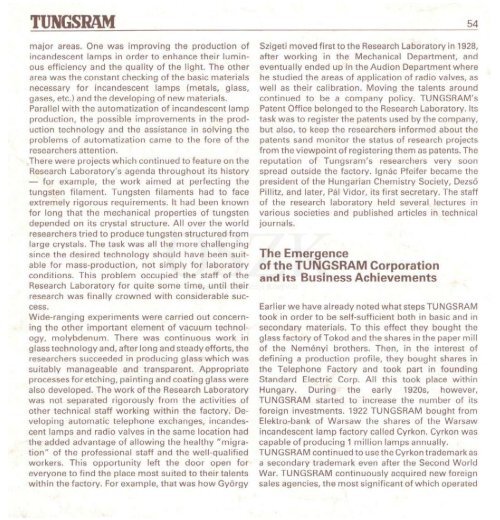THE HISTORY OF TUNGSRAM 1896-1945 - MEK
THE HISTORY OF TUNGSRAM 1896-1945 - MEK
THE HISTORY OF TUNGSRAM 1896-1945 - MEK
- No tags were found...
You also want an ePaper? Increase the reach of your titles
YUMPU automatically turns print PDFs into web optimized ePapers that Google loves.
<strong>TUNGSRAM</strong> 54major areas. One was improving the production ofincandescent lamps in order to enhance their luminousefficiency and the quality of the light. The otherarea was the constant checking of the basic materialsnecessary for incandescent lamps (metals, glass,gases, etc.) and the developing of new materials.Parallel with the automatization of incandescent lampproduction, the possible improvements in the productiontechnology and the assistance in solving the, problems of automatization came to the fore of the\ researchers attention.'' There were projects which continued to feature on theResearch Laboratory's agenda throughout its history— for example, the work aimed at perfecting thetungsten filament. Tungsten filaments had to faceextremely rigorous requirements. It had been knownfor long that the mechanical properties of tungstendepended on its crystal structure. All over the worldresearchers tried to produce tungsten structured fromlarge crystals. The task was all the more challengingsince the desired technology should have been suitablefor mass-production, not simply for laboratoryconditions. This problem occupied the staff of theResearch Laboratory for quite some time, until theirresearch was finally crowned with considerable success.Wide-ranging experiments were carried out concerningthe other important element of vacuum technology,molybdenum. There was continuous work inglass technology and, after long and steady efforts, theresearchers succeeded in producing glass which wassuitably manageable and transparent. Appropriateprocesses for etching, painting and coating glass werealso developed. The work of the Research Laboratorywas not separated rigorously from the activities ofother technical staff working within the factory. Developingautomatic telephone exchanges, incandescentlamps and radio valves in the same location hadthe added advantage of allowing the healthy "migration"of the professional staff and the well-qualifiedworkers. This opportunity left the door open foreveryone to find the place most suited to their talentswithin the factory. For example, that was how GyorgySzigeti moved first to the Research Laboratory in 1928,after working in the Mechanical Department, andeventually ended up in the Audion Department where ,.he studied the areas of application of radio valves, aswell as their calibration. Moving the talents aroundcontinued to be a company policy. <strong>TUNGSRAM</strong>'SPatent Office belonged to the Research Laboratory. Itstask was to register the patents used by the company,but also, to keep the researchers informed about thepatents sand monitor the status of research projectsfrom the viewpoint of registering them as patents. Thereputation of Tungsram's researchers very soonspread outside the factory. Ignac Pfeifer became thepresident of the Hungarian Chemistry Society, DezsoPillitz, and later, Pal Vidor, its first secretary. The staffof the research laboratory held several lectures invarious societies and published articles in technicaljournals.The Emergenceof the <strong>TUNGSRAM</strong> Corporationand its Business Achievements^^•Earlier we have already noted what steps <strong>TUNGSRAM</strong>took in order to be self-sufficient both in basic and insecondary materials. To this effect they bought theglass factory of Tokod and the shares in the paper millof the Nemenyi brothers. Then, in the interest ofdefining a production profile, they bought shares inthe Telephone Factory and took part in foundingStandard Electric Corp. All this took place withinHungary. During the early 1920s, however,<strong>TUNGSRAM</strong> started to increase the number of itsforeign investments. 1922 <strong>TUNGSRAM</strong> bought fromElektro-bank of Warsaw the shares of the Warsawincandescent lamp factory called Cyrkon. Cyrkon wascapable of producing 1 million lamps annually.<strong>TUNGSRAM</strong> continued to use the Cyrkon trademark asa secondary trademark even after the Second WorldWar. <strong>TUNGSRAM</strong> continuously acquired new foreignsales agencies, the most significant of which operated••-.._. ....... I .. •-








![Letöltés egy fájlban [4.3 MB - PDF]](https://img.yumpu.com/50159926/1/180x260/letaltacs-egy-fajlban-43-mb-pdf.jpg?quality=85)







